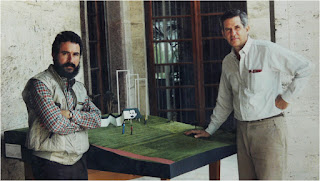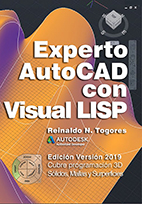
With Thomas Lara (left) At the Italo-Latin American Cultural Institute.
The monument to José Martí in Rome was the result of a contest sponsored by the Commission for the Development of Monumental and Environmental Sculpture (CODEMA) in 1988. I took part in a team with sculptor Tomás Lara. For this monument several proposals were made. The one presented to the competition was elaborated using a series of photos of the proposed site, and took into account both the guidelines established by the Commission and the experience gathered from other monuments already built (the Madrid) or then under development (Quito and Paris).
This initial project, when presented to the Roman municipality was objected arguing that it included a paved foundation and regulations called for preserving as much as possible the natural environment. The Italo-Latin American Cultural Institute, which promoted the monument, then offered us, in addition to accommodation, a place for preparing the modified project. The model shown in the photo was prepared the studio that sculptor Federico Brook, Deputy Secretary of the Cultural Institute had in the Trastevere neighborhood. Local authorities delayed their approval with a series of objections that were the subject of two additional variants of the project. There were also aesthetic prejudices: "Too modern it would be fine for Brasilia, but in Rome ... Rome is classical".
The project's approval remained pending upon our return to Havana. Some time later we learned that it had been rejected, this time for being too magnificent. They finally set a series of conditions in which the monument was reduced to a two meters high stele. We were in a situation where we are almost forced to adopt a completely conventional typology, to the extent that their specifications included a dimensioned drawing of a plaque with Martí's portrait in a bas-relief circular medallion. Failure to accept these conditions would have meant giving up our desire for a worthy monument. It was no longer possible to readjust the initial project. We had to start from scratch discarding all the work done, and all this within a short time limit defined by the goal of inaugurating it on January 28 (1989).
A number of variants among which the new proposal to discuss with the Roman authorities would be chosen were then developed. In all of them the traditional figure-pedestal scheme imposed on us was critically approached, questioning its hierarchical nature. We were convinced that it would be necessary to destroy that distinct image - bearing element separation, that allowed the identification of each of them. This would finally achieve a unitary monumental lecture in which what would have been merely pedestal, is involved as an active figurative element. Closely related to this is its conception in the round, where every change of perspective leads to the discovery of new developments in which front, back or side are purely functional distinctions that do not involve privilege regarding their formal weight. Despite its small size, the location the terrain's vantage point and its volumetry's strength contribute to its monumental character.
To the concept and intentions of this project I have referred in the paper read as part of the cycle of lectures organized on the occasion of the creation of the section of the Association of Plastic Artists' Environmental Design Section within the Cuban National Union of Writers and Artists (UNEAC) which I reproduce below:
In this case the starting point was a phrase suggested byhistorian Pedro Alvarez-Tabío: "I want the first law ofour republic to be the respect of Cubans to the full dignity ofMan ' (25). This statement highlights a facet of Marti's personality, that of the man of law, both from trainingas from vocation.The archetype of our modern codes of law is found in Roman Law. This idea evokes in us, immediately, the place of law: the Roman Forum. From the colonnades that once surrounded it only remains have endured. Just two or three shafts, here and there, supporting pieces of entablature. Of those vestiges of the ancient forum sprouts a first image, a slender portico that reproduces the proportions of intercolumnia in ancient basilicas. The space defined by this structure can also be read as door. Doors, colossal doors, were precisely the memorials of the great feats in Roman antiquity. In triumphal arches the door motif is often reiterated triplicating it.
Doors invite the passage therethrough, marking a path. The direction of travel is emphasized by establishing a sequence in depth and height.Life, and in particular that of someone like Martí can be seen as a path, a path which is traversed despite the obstacles encountered. The path defined by the succession of porticoes must overcome the terrain's slope and the steepness of the foundation to find, lastly, the wall against which it crashes. Fitting conclusion to the path of he who claimed 'let the Star That iluminates and kills brightly glow on my brow'(26). On the impact, the wall shatters, its sharp planes shifting in a flurry in which they could become a star, but a flag as well.
Martí, on reaching his destiny -the star- becomes the flag. The wall with his image, shatters, the rises to the wind, fluttering as should have the cavalry banners in that action in which he met his death. Marti, the man of law, we arrived in this flow of images to Martí, a flag. From the political project of a republic to the personal destiny of a man.
This monument remained a project. Local authorities, perhaps because of political color changes, delayed its approval with a number of objections that were the reason for two additional project variants. Eventually conditions were established from which the monument was reduced to a two meters high stela. The idea of the porches abandoned, the topic of the star remains, suggested from the intersection of planes. The original intention of using white and green marble was objected as well by the local authorities because of the danger of the omnipresent graffiti. The material used at the request of the zone's chief engineer will undoubtedly facilitate the work of city employees but introduces, with that star in red granite, suggestions perhaps appropriate to the ideological affiliation of our current government, but certainly foreign to the conservative officials that, taking into account only the functional aspect, promoted its use.
Even now we believe that the first solution was, because of its scale and its rich symbolism, the best both for the venue as for the subject. If perhaps at that time in Rome certain political circumstances were given, and who knows if also some neglect on the part of those who could back us more forcefully, we'll never lose hope for seeing this proposal made real someday. Occasions to honor Martí certainly have not been exhausted.




